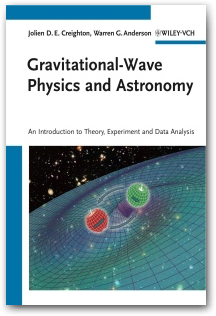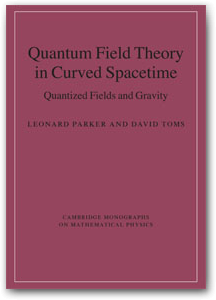Gravitational-Wave Physics and Astronomy

Jolien Creighton
Warren Anderson
Wiley, November 2011
ISBN: 978-3-527-40886-3
Publisher's page
The most up-to-date, one-stop reference combines coverage of both theory and observational techniques, with introductory sections to bring all readers up to the same level. Written by outstanding researchers directly involved with the scientific program of the Laser Interferometer Gravitational-Wave Observatory (LIGO), the book begins with a brief review of general relativity before going on to describe the physics of gravitational waves and the astrophysical sources of gravitational radiation. Further sections cover gravitational wave detectors, data analysis, and the outlook of gravitational wave astronomy and astrophysics.
About the authorsJolien D. E. Creighton is an Associate Professor of Physics at the University of Wisconsin-Milwaukee and a member of the LIGO Scientific Collaboration, which he joined in 1998. He received his doctoral degree at the University of Waterloo where he studied the thermodynamical properties of black holes.
Warren G. Anderson is a scientist at the University of Wisconsin-Milwaukee and a member of the LIGO Scientific Collaboration, which he joined in 1998. He received his doctorate at the University of Alberta under Werner Israel, where he worked on Black Hole physics, and has also held a tenure track position at The University of Texas at Brownsville. He also received Master's degrees in Medical Physics (University of Alberta) and Applied Mathematics (University of Waterloo).
Quantum Field Theory in Curved Spacetime

Leonard Parker
David Toms
Cambridge University Press, August 2009
ISBN-13: 9780521877879
Publisher's page
Quantum field theory in curved spacetime has been remarkably fruitful. It can be used to explain how the large-scale structure of the universe and the anisotropies of the cosmic background radiation that we observe today first arose. Similarly, it provides a deep connection between general relativity, thermodynamics, and quantum field theory.
This book develops quantum field theory in curved spacetime in a pedagogical style, suitable for graduate students. The authors present detailed, physically motivated, derivations of cosmological and black hole processes in which curved spacetime plays a key role. They explain how such processes in the rapidly expanding early universe leave observable consequences today, and how in the context of evaporating black holes, these processes uncover deep connections between gravitation and elementary particles. The authors also lucidly describe many other aspects of free and interacting quantized fields in curved spacetime.
About the authorsLeonard Parker is a Distinguished Professor at the University of Wisconsin-Milwaukee and a founding member of the Center for Gravitation and Cosmology.
David Toms is a Reader at Newcastle-upon-Tyne University.